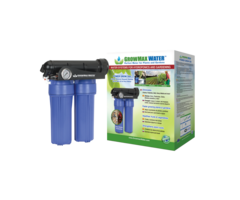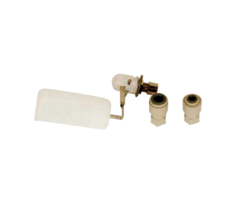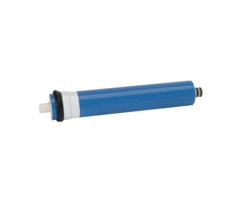Osmosis Water Systems ~ Pure water for your crop
Osmosis systems have been used in horticulture for many years to improve water quality and increase crop yields. Osmosis is a natural process in which water flows through a membrane to separate dissolved substances. This technique is often used in horticulture to purify water and rid it of minerals and other contaminants that can be harmful to the crop.
How does osmosis work?
Osmosis is a technique in which water flows through a membrane to separate dissolved substances to create osmosis water. This process occurs when there is a concentration difference between the two sides of the membrane. In horticulture, osmosis is often used to purify water and rid it of minerals and other contaminants.
An osmosis system consists of a number of different components, including a pre-filter, a reverse osmosis membrane and a post-filter. The prefilter removes larger particles and contaminants from the water before it passes through the membrane. The reverse osmosis membrane is the most important part of the system and ensures that minerals and other contaminants are purged from the water. The post-filter is used to further improve the purity of the water before it is delivered to the crop.
Benefits of osmosis systems in horticulture
An Osmosis system offers several benefits to a grower. First, the pure water ensures that the crops do not ingest harmful minerals or other contaminants that can hinder growth.
Second, using an osmosis system can increase crop yields because the crops get all the nutrients they need to grow and flourish.
Third, osmosis water can extend the life of irrigation systems because the water does not contain harmful minerals that can cause corrosion.
Osmosis systems are also sustainable and environmentally friendly because they reduce the use of chemicals otherwise needed to purify water. Using an osmosis system can also reduce water consumption because the osmosis water is used more efficiently by the crop and is not wasted by excess minerals.

Conclusion
An Osmosis system is a valuable device for horticulture because it provides pure water that is essential for crop growth, flowering and yield. Using osmosis systems can also lead to more sustainable and environmentally friendly horticultural practices by reducing the use of chemicals and water. It is crucial to properly maintain your osmosis system, its effectiveness and efficiency will deteriorate if it is not properly maintained. Regular inspection and replacement of filters and membranes is essential to achieve the best results and extend the life of the system.
Osmosis systems have been used in horticulture for many years to improve water quality and increase crop yields. Osmosis is a natural process in which water flows through a membrane to separate dissolved substances. This technique is often used in horticulture to purify water and rid it of minerals and other contaminants that can be harmful to the crop.
How does osmosis work?
Osmosis is a technique in which water flows through a membrane to separate dissolved substances to create osmosis water. This process occurs when there is a concentration difference between the two sides of the membrane. In horticulture, osmosis is often used to purify water and rid it of minerals and other contaminants.
An osmosis system consists of a number of different components, including a pre-filter, a reverse osmosis membrane and a post-filter. The prefilter removes larger particles and contaminants from the water before it passes through the membrane. The reverse osmosis membrane is the most important part of the system and ensures that minerals and other contaminants are purged from the water. The post-filter is used to further improve the purity of the water before it is delivered to the crop.
Benefits of osmosis systems in horticulture
An Osmosis system offers several benefits to a grower. First, the pure water ensures that the crops do not ingest harmful minerals or other contaminants that can hinder growth.
Second, using an osmosis system can increase crop yields because the crops get all the nutrients they need to grow and flourish.
Third, osmosis water can extend the life of irrigation systems because the water does not contain harmful minerals that can cause corrosion.
Osmosis systems are also sustainable and environmentally friendly because they reduce the use of chemicals otherwise needed to purify water. Using an osmosis system can also reduce water consumption because the osmosis water is used more efficiently by the crop and is not wasted by excess minerals.

Conclusion
An Osmosis system is a valuable device for horticulture because it provides pure water that is essential for crop growth, flowering and yield. Using osmosis systems can also lead to more sustainable and environmentally friendly horticultural practices by reducing the use of chemicals and water. It is crucial to properly maintain your osmosis system, its effectiveness and efficiency will deteriorate if it is not properly maintained. Regular inspection and replacement of filters and membranes is essential to achieve the best results and extend the life of the system.
Available in: 20l/h | 40l/h | 125l/h....
Osmosis systems have been used in horticulture for many years to improve water quality and increase crop yields. Osmosis is a natural process in which water flows through a membrane to separate dissolved substances. This technique is often used in horticulture to purify water and rid it of minerals and other contaminants that can be harmful to the crop.
How does osmosis work?
Osmosis is a technique in which water flows through a membrane to separate dissolved substances to create osmosis water. This process occurs when there is a concentration difference between the two sides of the membrane. In horticulture, osmosis is often used to purify water and rid it of minerals and other contaminants.
An osmosis system consists of a number of different components, including a pre-filter, a reverse osmosis membrane and a post-filter. The prefilter removes larger particles and contaminants from the water before it passes through the membrane. The reverse osmosis membrane is the most important part of the system and ensures that minerals and other contaminants are purged from the water. The post-filter is used to further improve the purity of the water before it is delivered to the crop.
Benefits of osmosis systems in horticulture
An Osmosis system offers several benefits to a grower. First, the pure water ensures that the crops do not ingest harmful minerals or other contaminants that can hinder growth.
Second, using an osmosis system can increase crop yields because the crops get all the nutrients they need to grow and flourish.
Third, osmosis water can extend the life of irrigation systems because the water does not contain harmful minerals that can cause corrosion.
Osmosis systems are also sustainable and environmentally friendly because they reduce the use of chemicals otherwise needed to purify water. Using an osmosis system can also reduce water consumption because the osmosis water is used more efficiently by the crop and is not wasted by excess minerals.

Conclusion
An Osmosis system is a valuable device for horticulture because it provides pure water that is essential for crop growth, flowering and yield. Using osmosis systems can also lead to more sustainable and environmentally friendly horticultural practices by reducing the use of chemicals and water. It is crucial to properly maintain your osmosis system, its effectiveness and efficiency will deteriorate if it is not properly maintained. Regular inspection and replacement of filters and membranes is essential to achieve the best results and extend the life of the system.







